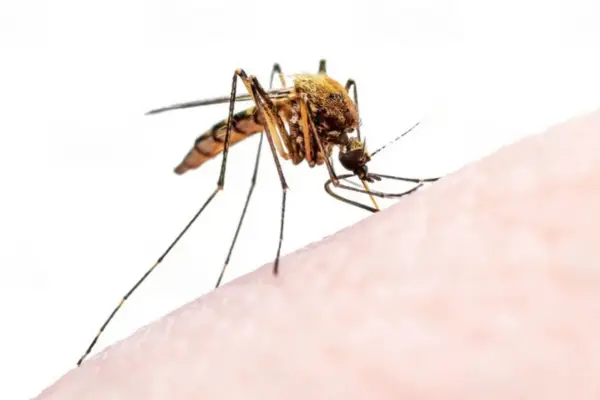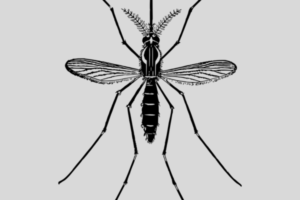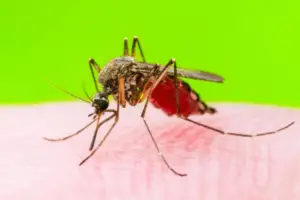Mosquito season commonly begins in the spring when outdoor temperatures reach 50°F. It persists through the summer and fall.
But here’s some good news for homeowners facing backyard mosquito issues: Mosquitoes aren’t always active.
Similar to ocean waves, mosquito presence fluctuates during the day. Understanding their active times might help your family enjoy outdoor time while evading bites.
When Do Mosquitoes Come Out?

Most mosquito types come out at dusk or in the evening. They like warm, humid places with easy water access, so they usually avoid the hottest and driest times of the day to prevent dehydration.
In the daytime, you’ll likely spot mosquitoes in shaded or wet spots. When dusk arrives, mosquitoes get quite hungry because they couldn’t find creatures to bite earlier.
This hunger makes them more likely to come out at dusk in a burst of activity.
After they’ve had their fill, mosquitoes hide and rest until dawn. It’s crucial to keep mosquitoes out of your home because of this behavior.
Without protection from these flying pests, they might bite people and pets during the night, simply because were easy targets
When Are Mosquitoes Most Active?
People often ask, “When are mosquitoes active?” Although it’s not possible to avoid all times of the day, understanding when mosquitoes are most active is crucial.
Summer Season:
As previously mentioned, mosquitoes thrive in temperatures ranging from 50 to 80 degrees Fahrenheit. This is why they emerge during the summer season, typically from March to early November.
However, they tend to avoid direct sunlight and extreme heat. Female mosquitoes seek out damp soil and stagnant water to maintain the moisture needed for breeding.
Early Morning:
You might have observed mosquitoes flying around during the early morning hours. Mornings in Texas are usually cooler and more humid, creating ideal conditions for mosquitoes.
During this period, they can evade the sun’s rays. If the air holds moisture, they might find dewy puddles to quench their thirst. This also means that as you tackle your outdoor tasks in the morning’s cooler weather, you’re likely to encounter mosquito bites.
Throughout the Night:
Similar to early mornings, dusk and nighttime are peak times for mosquitoes. This explains why you’ll be swatting away these bothersome insects while trying to cook and socialize outdoors.
At this juncture, many people turn to sprays and candles to repel mosquitoes, attempting to make the most of their outdoor space.
Species Variation:
Although the time of day matters, certain mosquito species remain active throughout the day.
For example, the Asian Tiger Mosquito is prone to biting during daylight hours and can transmit illnesses such as West Nile virus. Conversely, Southern Mosquitoes tend to emerge only at night.
.Other Most Active Mosquito Times
With 176 mosquito species in the US, each differs in activity, habits, and habitats. Some favor daytime, others dawn or dusk. US mosquitoes are often most active before sunset. Evening outdoor plans, especially near water in shaded areas, demand protection against bites.
Two common mosquito species causing issues are Aedes aegypti (the Asian tiger mosquito) and Culex pipiens (the common house mosquito). Asian tiger mosquitoes bite more during the day, while common house mosquitoes prefer mornings and late afternoons.
Hot parts of the day, when the sun is intense, see fewer mosquitoes. Yet indoor conditions shield them from the sun’s drying effects, making them more active indoors, seeking a target to bite.
Without protection, mosquitoes may bite humans and pets overnight, as they’re easy prey.
Factors That Influence Mosquito Active Times
Primarily, mosquitoes are most active around dawn and dusk. They tend to avoid the midday sun due to the risk of dehydration in direct sunlight and high temperatures.
However, this is not an absolute rule; the timing of mosquito activity can vary based on:
- Weather
- Temperature
- Species
1. Weather
When it comes to weather, mosquitoes generally stay away from prolonged sun exposure.
Bright, sunny days around noon are less appealing to them. Cloudy days, on the other hand, can disrupt this pattern.
2. TemperatureT
The environment plays a vital role too. The ideal range for mosquitoes is 64–93 °F (18–34 °C), with peak activity at around 80 °F.
Depending on the month and location, this range might translate to different hours of the day.
3. species.
The active times of mosquitoes can also change based on their species. For instance, if your surroundings have multiple mosquito species, their activity times might overlap.
In New York, two common mosquito species are Culex and Aedes. Culex mosquitoes can carry West Nile virus, while Aedes mosquitoes transmit diseases like dengue, yellow fever, and Zika virus.
There’s also Anopheles, which carries malaria but is less common than the other two.
Let’s delve into each species:
Culex Mosquitoes
Culex includes the widely found Culex pipiens (northern house mosquito) in NYC.
These mosquitoes are active from dusk to dawn, primarily hiding during the day in shaded areas or beneath foliage.
Their peak outdoor activity times are from 8:00 p.m. to 6:00 a.m., extending into the early morning.
Aedes Mosquitoes
Aedes mosquitoes, like the Asian tiger mosquito and the yellow fever mosquito, are known for aggressive bites.
They emerge during twilight before sunrise and reappear around sunset. In NYC’s peak mosquito season, they are most active outdoors between 5:00 a.m. and 7:00 a.m. and 7:00 p.m. and 9:00 p.m.
They are also active indoors or in shady spots, even during the day or when it’s cloudy.
Anopheles Mosquitoes
Anopheles mosquitoes, associated with malaria, have varied activity times. Some are more active at dusk and dawn, while others are active throughout the night. Their peak biting times are similar to those of Culex mosquitoes.
In conclusion, mosquito activity times are influenced by factors like weather, temperature, and species.
Understanding these patterns can help people take precautionary measures against mosquito bites.
Optimal Times of Day to Prevent Mosquito Bites Outdoors
In general, the most favorable period for outdoor activities during mosquito season is midday, particularly when the weather is sunny and bright.
To minimize mosquito bites, restrict your outdoor exposure during early mornings and late evenings (around sunrise and sunset).
Additional instances and locations where mosquitoes are typically less active include:
- When there’s a breeze (since mosquitoes are not strong fliers),
- Spots with abundant direct sunlight and minimal shade
- Areas that are distant from thick vegetation and stagnant water
Effective Strategies for Mosquito Control on Your Premises
Numerous DIY solutions exist for eradicating or repelling mosquitoes, a topic we’ll delve into in a separate article. However, if you’re tired of enduring mosquito bites in your own yard, contemplate enlisting the services of professional mosquito sprayers.
Professionals in mosquito control, such as those at MMPC, possess access to potent and environmentally friendly mosquito repellents, cutting-edge equipment, and specialized expertise to apply them precisely in targeted zones where mosquitoes are prone to concealment.
For homeowners in New York City, reach out to MMPC now to explore our efficient and budget-friendly mosquito management programs.
Understanding Mosquito Season
The onset of mosquito season is entirely governed by temperature. Once a locality sustains temperatures consistently above 45°F, mosquitoes will either hatch or emerge vigorously from hibernation.
Warmer regions might encounter a surge in mosquito activity sooner than cooler areas, making it essential to monitor temperatures in your vicinity for adequate preparedness.
When temperatures ascend to 80°F, mosquitoes will become a persistent issue.
Before considering a move to cooler environs, there are various ways to prepare your residence and land to diminish the severity of mosquito season.
- Early Preparation: Once the temperature starts rising, clear your yard of debris or refuse that could potentially hold water. Procure indoor and outdoor DynaTrap. Insect Traps in advance for prompt action when mosquito season arrives.
- Avoid Peak Mosquito periods. Adjust your outdoor schedule to mitigate the risk of bites.
- Fortify Your Residence: Install screens or mend existing ones on doors and windows. Even the smallest openings can beckon mosquitoes.
- Prudent Travel: If visiting a mosquito-prone region, opt for off-peak times to decrease your vulnerability. Stay updated on necessary vaccinations to further minimize disease risk during travel.
Where Mosquitoes are Most Active
Understanding the timing of mosquito activity is half the challenge. Equally important is recognizing zones with a higher potential for mosquito bites.
Different mosquito species exhibit preferences for distinct environments, but the majority are inclined towards shadowy, damp, and moist locations like woodlands or anywhere with stagnant water.
Being mindful of your surroundings empowers you to take added precautions to curtail the odds of mosquito bites.
In case your locality is grappling with an upsurge in mosquito-linked diseases, concerns about infection during illness arise, or adverse reactions to mosquito bites trouble you, opting to remain indoors during peak mosquito periods might be the optimal choice.
Nevertheless, unless compelled by medical reasons, there’s no necessity to revise your routine due to mosquitoes.
Gaining insights into the times and places where mosquitoes are prone to being bothersome, coupled with adopting appropriate safeguards, substantially mitigates the risk of mosquito bites
Why Are Mosquitoes More Active at Night?
The majority of mosquito species in the United States show increased activity from dusk until dawn.
This means that if you venture outside during this time, your chances of getting bitten are higher.
Individuals who reside near wooded areas, wetlands, or shaded locations with stagnant water (ideal breeding sites for mosquitoes) face an elevated risk of insect bites.
Interestingly, certain studies suggest that mosquito activity can spike significantly, possibly by up to 500 percent, during a full moon.
In reality, mosquitoes’ nighttime activity is more about avoiding daytime sun exposure.
These flying pests steer clear of direct sunlight due to the risk of dehydration.
Given that mosquitoes typically have just a week or two to live, exposure to direct sunlight can quickly dehydrate them, leading to dire consequences.
Are Mosquitoes Active During the Day?
For the most part, mosquitoes tend to avoid the peak hours of daylight. Much like mythical vampires shunning sunlight, mosquitoes limit their activities during the daytime, preferring to seek blood, their life source, when night falls.
Mosquitoes have a preference for shaded and humid areas to avoid direct sunlight.
Damp wetlands, pockets of woodland, and even well-landscaped gardens all serve as safe havens where mosquitoes can rest or sleep during the hottest and sunniest periods of the day.
Why Should You Be Concerned About Mosquito Activity?
Given the recent surge in cases of West Nile virus and Zika virus, understanding the times when mosquitoes are most active can contribute to the safety of you and your family.
Throughout history, mosquitoes have been responsible for transmitting diseases like malaria, dengue fever, and yellow fever.
Shockingly, estimates suggest that mosquitoes have played a role in about half of all recorded human deaths due to their efficient transmission of diseases like malaria during feeding.
Do Mosquitoes Follow a Seasonal Pattern?
Contrary to a fixed seasonal pattern, mosquitoes are more attuned to temperature changes.
Their reproductive and feeding patterns are dictated more by shifts in weather conditions—thawing or freezing—rather than adhering to a specific calendar.
As colder months set in, some mosquito species die off while others enter a hibernation-like state, particularly when temperatures drop to around 50 degrees
Fahrenheit or lower. When temperatures consistently rise above 50 degrees Fahrenheit, hibernating adult mosquitoes emerge, and their winter-laid eggs hatch.
In the United States, mosquito activity varies by region due to local temperature and climate variations.
Some southern states experience continuous mosquito activity, while areas like New England and the Pacific Northwest might encounter a shorter season from late spring to early fall.
How Can You Minimize Exposure to Mosquitoes at Night or During Mosquito Season?
Most individuals only take action against mosquitoes once they’re dealing with itchy bites.
However, waiting until mosquitoes hatch or emerge from hibernation means you’re already on the losing side of the battle.
To address the issue before it escalates, it’s wise to collaborate with a seasoned pest control provider like MosquitoNix. Mosquito Magnet, Mosquito Joe etc.
By initiating preventive measures early, you can stay ahead. This involves setting up targeted misting systems or arranging fogging treatments in advance.
The expertise of professionals can help eradicate mosquitoes from their breeding and hibernation sites, nipping the problem in the bud.





